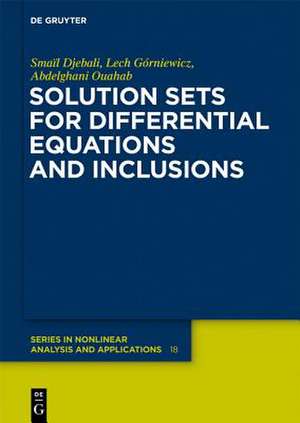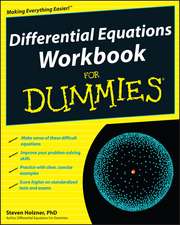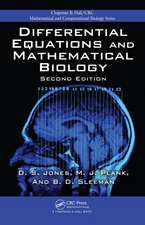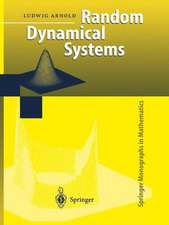Solution Sets for Differential Equations and Inclusions: de Gruyter Series in Nonlinear Analysis and Applications, cartea 18
Autor Smaïl Djebali, Lech Górniewicz, Abdelghani Ouahaben Limba Engleză Hardback – 14 noi 2012
The book is intended to advanced graduate researchers and instructors active in research areas with interests in topological properties of fixed point mappings and applications; it also aims to provide students with the necessary understanding of the subject with no deep background material needed. This monograph fills the vacuum in the literature regarding the topological structure of fixed point sets and its applications.
Din seria de Gruyter Series in Nonlinear Analysis and Applications
- 23%
 Preț: 1306.91 lei
Preț: 1306.91 lei - 23%
 Preț: 2191.38 lei
Preț: 2191.38 lei - 23%
 Preț: 1384.23 lei
Preț: 1384.23 lei - 23%
 Preț: 1642.60 lei
Preț: 1642.60 lei - 23%
 Preț: 1650.74 lei
Preț: 1650.74 lei - 9%
 Preț: 1063.21 lei
Preț: 1063.21 lei - 23%
 Preț: 1771.89 lei
Preț: 1771.89 lei - 9%
 Preț: 986.28 lei
Preț: 986.28 lei - 23%
 Preț: 1425.95 lei
Preț: 1425.95 lei - 23%
 Preț: 1158.87 lei
Preț: 1158.87 lei - 9%
 Preț: 973.62 lei
Preț: 973.62 lei - 9%
 Preț: 911.17 lei
Preț: 911.17 lei - 23%
 Preț: 1068.01 lei
Preț: 1068.01 lei - 23%
 Preț: 978.41 lei
Preț: 978.41 lei - 23%
 Preț: 1814.89 lei
Preț: 1814.89 lei - 23%
 Preț: 1767.81 lei
Preț: 1767.81 lei - 23%
 Preț: 1305.11 lei
Preț: 1305.11 lei - 23%
 Preț: 850.40 lei
Preț: 850.40 lei - 23%
 Preț: 1156.94 lei
Preț: 1156.94 lei - 23%
 Preț: 1162.14 lei
Preț: 1162.14 lei - 23%
 Preț: 1531.52 lei
Preț: 1531.52 lei - 27%
 Preț: 617.62 lei
Preț: 617.62 lei - 27%
 Preț: 1209.98 lei
Preț: 1209.98 lei - 27%
 Preț: 614.44 lei
Preț: 614.44 lei - 27%
 Preț: 1463.78 lei
Preț: 1463.78 lei
Preț: 1437.64 lei
Preț vechi: 1867.07 lei
-23% Nou
275.13€ • 284.22$ • 228.98£
Carte tipărită la comandă
Livrare economică 25 martie-08 aprilie
Specificații
ISBN-10: 3110293447
Pagini: 472
Ilustrații: 3 schw.-w. Abb.
Dimensiuni: 170 x 240 x 30 mm
Greutate: 0.93 kg
Editura: De Gruyter
Colecția De Gruyter
Seria de Gruyter Series in Nonlinear Analysis and Applications
Locul publicării:Berlin/Boston
Notă biografică
Cuprins
1 TOPOLOGICAL STRUCTURE OF FIXED POINT SETS 11
1.1 Case of single-valued mappings . . . . . . . . . . . . . . . . . . . . . . 11
1.1.1 Fundamental ¯xed point theorems . . . . . . . . . . . . . . . . . 11
1.1.2 Approximation theorems . . . . . . . . . . . . . . . . . . . . . . 14
1.1.3 Browder{Gupta Theorems . . . . . . . . . . . . . . . . . . . . . 16
1.1.4 Acyclicity of the solution sets of operator equation . . . . . . . 21
1.1.5 Solution sets for nonexpansive maps . . . . . . . . . . . . . . . . 24
1.2 Case of multi-valued mappings . . . . . . . . . . . . . . . . . . . . . . . 25
1.2.1 Fixed point theorems . . . . . . . . . . . . . . . . . . . . . . . . 25
1.2.2 Multivalued contractions . . . . . . . . . . . . . . . . . . . . . . 27
1.2.3 Fixed point sets of multi-valued contractions . . . . . . . . . . . 29
1.2.4 Fixed point sets of multivalued condensing maps . . . . . . . . . 32
1.2.5 Approximation of multi-valued maps . . . . . . . . . . . . . . . 37
1.3 Admissible maps . . . . . . . . . . . . . . . . . . . . . . . . . . . . . . 40
1.3.1 Generalities . . . . . . . . . . . . . . . . . . . . . . . . . . . . . 40
1.3.2 Fixed point theorems for admissible multivalued maps . . . . . 48
1.3.3 Browder{Gupta type results for admissible mappings . . . . . . 54
1.4 Topological structure of ¯xed point sets of inverse limit maps . . . . . . 58
1.4.1 De¯nition . . . . . . . . . . . . . . . . . . . . . . . . . . . . . . 58
1.4.2 Basic properties . . . . . . . . . . . . . . . . . . . . . . . . . . . 58
1.4.3 Multi-maps of inverse systems . . . . . . . . . . . . . . . . . . . 60
1.5 Further results . . . . . . . . . . . . . . . . . . . . . . . . . . . . . . . 63
1.5.1 Semi-compactness in L1 . . . . . . . . . . . . . . . . . . . . . . 63
1.5.2 Decomposability in L1(T;E) . . . . . . . . . . . . . . . . . . . . 64
1.5.3 Michael family of subsets . . . . . . . . . . . . . . . . . . . . . . 66
2 EXISTENCE THEORY FOR DIFFERENTIAL EQUATIONS AND
INCLUSIONS 71
2.1 Case of di®erential equations . . . . . . . . . . . . . . . . . . . . . . . . 71
2.1.1 Existence and uniqueness results . . . . . . . . . . . . . . . . . 71
2.1.2 Picard-LindelÄof Theorem . . . . . . . . . . . . . . . . . . . . . . 72
2.1.3 Peano and Carath¶eodory theorems . . . . . . . . . . . . . . . . 77
2.1.4 Global existence theorems . . . . . . . . . . . . . . . . . . . . . 79
2.1.5 Existence results on non-compact intervals . . . . . . . . . . . . 82
2.1.6 A boundary value problem on the half-line . . . . . . . . . . . . 89
2.2 Case of di®erential inclusions . . . . . . . . . . . . . . . . . . . . . . . 94
2.2.1 Initial value problem . . . . . . . . . . . . . . . . . . . . . . . . 94
2.2.2 A boundary value problem . . . . . . . . . . . . . . . . . . . . . 99
3 SOLUTIONS SETS FOR DIFFERENTIAL EQUATIONS AND IN-
CLUSIONS 105
3.1 Solutions sets for di®erential equations . . . . . . . . . . . . . . . . . . 105
3.1.1 Problems on bounded intervals . . . . . . . . . . . . . . . . . . 105
3.1.2 Problems on unbounded intervals . . . . . . . . . . . . . . . . . 107
3.1.3 Kneser-Hukuhara Theorem . . . . . . . . . . . . . . . . . . . . . 109
3.2 Aronszajn-type results for di®erential inclusions . . . . . . . . . . . . . 111
3.3 Application to neutral di®erential inclusions . . . . . . . . . . . . . . . 118
3.3.1 The convex case . . . . . . . . . . . . . . . . . . . . . . . . . . . 119
3.3.2 The nonconvex case . . . . . . . . . . . . . . . . . . . . . . . . . 125
3.3.3 Solutions sets . . . . . . . . . . . . . . . . . . . . . . . . . . . . 129
3.4 Application to second order di®erential inclusions . . . . . . . . . . . . 136
3.4.1 The convex case . . . . . . . . . . . . . . . . . . . . . . . . . . . 137
3.4.2 The nonconvex case . . . . . . . . . . . . . . . . . . . . . . . . . 141
3.4.3 Solution sets to second-order di®erential equations . . . . . . . . 144
3.4.4 Solution sets to second-order di®erential inclusions . . . . . . . 146
3.5 Application to a nonlocal problem . . . . . . . . . . . . . . . . . . . . . 150
3.5.1 Existence results . . . . . . . . . . . . . . . . . . . . . . . . . . 150
3.5.2 Solutions set . . . . . . . . . . . . . . . . . . . . . . . . . . . . . 151
3.6 Application to a nonlocal viability problem . . . . . . . . . . . . . . . . 152
3.6.1 Preliminaries . . . . . . . . . . . . . . . . . . . . . . . . . . . . 152
3.6.2 Viable solutions on proximate retracts . . . . . . . . . . . . . . 154
3.7 Application to hyperbolic di®erential inclusions . . . . . . . . . . . . . 158
3.7.1 Existence results . . . . . . . . . . . . . . . . . . . . . . . . . . 158
3.7.2 Solution sets . . . . . . . . . . . . . . . . . . . . . . . . . . . . . 164
3.8 Application to abstract Volterra operators . . . . . . . . . . . . . . . . 166
4 IMPULSIVE DIFFERENTIAL INCLUSIONS: EXISTENCE AND
SOLUTION SETS 169
4.1 Impulsive di®erential inclusions . . . . . . . . . . . . . . . . . . . . . . 169
4.1.1 C0¡Semigroups . . . . . . . . . . . . . . . . . . . . . . . . . . . 170
4.1.2 Motivation . . . . . . . . . . . . . . . . . . . . . . . . . . . . . . 172
4.1.3 Existence results . . . . . . . . . . . . . . . . . . . . . . . . . . 174
4.1.4 Structure of solution sets . . . . . . . . . . . . . . . . . . . . . . 190
4.2 A periodic problem . . . . . . . . . . . . . . . . . . . . . . . . . . . . . 203
4.2.1 Existence results: 1 2 ¿(T(b)) . . . . . . . . . . . . . . . . . . . 203
4.2.2 The convex case: direct approach . . . . . . . . . . . . . . . . . 204
4.2.3 The convex case: MNC approach . . . . . . . . . . . . . . . . . 211
4.2.4 The nonconvex case . . . . . . . . . . . . . . . . . . . . . . . . . 216
4.2.5 The parameter-dependant case . . . . . . . . . . . . . . . . . . 219
4.2.6 Filippov's Theorem . . . . . . . . . . . . . . . . . . . . . . . . . 224
4.2.7 Existence of solutions: 1 62 ¿(T(b)) . . . . . . . . . . . . . . . . 232
4.3 Impulsive Functional Di®erential Inclusions . . . . . . . . . . . . . . . . 238
4.3.1 Introduction . . . . . . . . . . . . . . . . . . . . . . . . . . . . . 238
4.3.2 Existence results . . . . . . . . . . . . . . . . . . . . . . . . . . 239
4.3.3 Structure of the solution set . . . . . . . . . . . . . . . . . . . . 247
4.4 Impulsive di®erential inclusions on the half-line . . . . . . . . . . . . . 251
4.4.1 Existence results and compactness of solution sets . . . . . . . . 252
4.4.2 Topological structure via the projective limit . . . . . . . . . . . 266
4.4.3 Using solution sets to prove existence results . . . . . . . . . . . 282
I SUPPLEMENTS 287
5 PRELIMINARY NOTIONS OF TOPOLOGY 289
5.1 Extension and embedding properties . . . . . . . . . . . . . . . . . . . 289
5.2 Homotopical properties of spaces . . . . . . . . . . . . . . . . . . . . . 296
5.3 ·Cech homology (cohomology) functor . . . . . . . . . . . . . . . . . . . 303
5.4 Maps of spaces of ¯nite type . . . . . . . . . . . . . . . . . . . . . . . . 304
5.5 ·Cech homology functor with compact carriers . . . . . . . . . . . . . . 311
5.6 Acyclic sets and Vietoris maps . . . . . . . . . . . . . . . . . . . . . . . 313
5.7 Homology of open subsets of Euclidean spaces . . . . . . . . . . . . . . 317
5.8 Lefschetz number . . . . . . . . . . . . . . . . . . . . . . . . . . . . . . 321
5.9 Coincidence problem . . . . . . . . . . . . . . . . . . . . . . . . . . . . 327
6 BACKGROUND IN MULTI-VALUED ANALYSIS 335
6.1 Continuity of multivalued mappings . . . . . . . . . . . . . . . . . . . . 337
6.1.1 Basic notions . . . . . . . . . . . . . . . . . . . . . . . . . . . . 337
6.1.2 Upper semi-continuity . . . . . . . . . . . . . . . . . . . . . . . 339
6.1.3 Lower semi-continuity . . . . . . . . . . . . . . . . . . . . . . . 344
6.1.4 Hausdor® continuity . . . . . . . . . . . . . . . . . . . . . . . . 347
6.2 Selection theorems . . . . . . . . . . . . . . . . . . . . . . . . . . . . . 349
6.2.1 Partitions of unity . . . . . . . . . . . . . . . . . . . . . . . . . 349
6.2.2 Michael's selection theorem . . . . . . . . . . . . . . . . . . . . 350
6.2.3 ¿¡selectionable mappings . . . . . . . . . . . . . . . . . . . . . 353
6.2.4 The Kuratowski-Ryll-Nardzewski selection theorem . . . . . . . 356
6.2.5 Hausdor®-measurable multivalued maps . . . . . . . . . . . . . 371
6.2.6 The Scorza-Dragoni property . . . . . . . . . . . . . . . . . . . 373
6.2.7 The Bressan-Colombo-Fryszkowski selection theorem . . . . . . 379
6.3 The Bochner integral . . . . . . . . . . . . . . . . . . . . . . . . . . . . 380
6.3.1 Generalities . . . . . . . . . . . . . . . . . . . . . . . . . . . . . 380
6.3.2 Nemytski·i operators . . . . . . . . . . . . . . . . . . . . . . . . 383
6.3.3 Integration of multivalued maps . . . . . . . . . . . . . . . . . . 386
6.4 Compactness in C([a; b];E) and PC([a; b];E) . . . . . . . . . . . . . . . 388
6.5 Further auxiliary results . . . . . . . . . . . . . . . . . . . . . . . . . . 391













